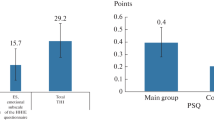Abstract
Patients with single sided-deafness (SSD) have hearing deficits amounting to a handicap to their everyday quality of life and are likely to suffer serious social challenges. There is a significant gap in the “disability” aspect of SSD in literature. The study was undertaken to compare the quality of life of SSD patients in various domains with normal hearing individuals. 51 patients of SSD with pure sensorineural hearing loss with impaired ear having a pure tone average of more than or equal to 70 dB was compared with 50 subjects with normal hearing sensitivity. Pure tone audiometric testing and the english version of Speech, Spatial and Qualities of Hearing Scale (SSQ) were used to enumerate subjective advantage. Total average SSQ score across domains in patients (6.6 ± 1.2) was significantly poorer in comparison to the control group (8.4 ± 0.9). Based on SSQ, patients with SSD experience hearing disability in comparison to the control group (p < 0.01). The ratings of all the items in the SSQ subdomains were higher in the reference group than in the patient group. Individuals with single sided-deafness experience significant auditory disability in all the three domains of speech, spatial & qualities of hearing. Therefore, these patients should be strongly counselled for currently available treatment options.



Similar content being viewed by others
Availability of Data and Material
All data and material are available in institute’s record.
References
Bronkhorst AW, Plomp R (1988) The effect of head-induced interaural time and level differences on speech intelligibility in noise. J Acoust Soc Am 83(4):1508–1516. https://doi.org/10.1121/1.395906
Douglas SA, Yeung P, Daudia A, Gatehouse S, O’Donoghue GM (2007) Spatial hearing disability after acoustic neuroma removal. Laryngoscope 117(9):1648–1651. https://doi.org/10.1097/MLG.0b013e3180caa162
Olsen SO, Hernvig LH, Nielsen LH (2012) Self-reported hearing performance among subjects with unilateral sensorineural hearing loss. Audiol Med 10(2):83–92. https://doi.org/10.3109/1651386X.2012.673755
Pai I, Kelleher C, Nunn T, Pathak N, Jindal M, O’Connor FG, Jiang D (2012 Jul) Outcome of bone-anchored hearing aids for single-sided deafness: a prospective study. Acta Otolaryngol 132(7):751–755. https://doi.org/10.3109/00016489.2012.655862
Gay A, Guinand N, Miffon M, Guyot JP (2015) Perception of discomfort caused by a unilateral hearing loss In people suffering from a total bilateral vestibular loss. ORL J Otorhinolaryngol Relat Spec 77(4):248–253. https://doi.org/10.1159/000433552
Varshney S (2016) Deafness in India. Indian J Otol 22(2):73–76. https://doi.org/10.4103/0971-7749.182281
Noble W, Gatehouse S (2004) Interaural asymmetry of hearing loss, speech, spatial and qualities of hearing scale (SSQ) disabilities, and handicap. Int J Audiolog 43(2):100–114. https://doi.org/10.1080/14992020400050015
Demeester K, Topsakal V, Hendrickx J-J, Fransen E, van Laer L, Van Camp G et al (2012) Hearing disability measured by the speech, spatial, and qualities of hearing scale in clinically normal-hearing and hearing-impaired middle-aged persons, and disability screening by means of a reduced SSQ (the SSQ5). Ear Hear 33(5):615–616. https://doi.org/10.1097/AUD.0b013e31824e0ba7
Banh J, Singh G, Pichora-Fuller MK (2012) Age affects responses on the speech, spatial, and qualities of hearing scale (SSQ) by adults with minimal audiometric loss. J Am Acad Audiol 23(2):81–91. https://doi.org/10.3766/jaaa.23.2.2
Priwin C, Jönsson R, Magnusson L, Hultcrantz M, Granstrom G (2007) Audiological evaluation and self- assessed hearing problems in subjects with single-sided congenital external ear malformations and associated conductive hearing loss. Int J Audiol 46(4):162–171. https://doi.org/10.1080/14992020601077984
Avan P, Giraudet F, Büki B (2015) Importance of binaural hearing. Audiol Neurotol 20(1):3–6. https://doi.org/10.1159/000380741
McLeod B, Upfold L, Taylor A (2008) Self reported hearing difficulties following excision of vestibular schwannoma. Int J Audiol 47(7):420–424. https://doi.org/10.1080/14992020802033083
Middlebrooks JC, Green DM (1991) Sound localization by human listeners. Annu Rev Psychol 42(1):135–159. https://doi.org/10.1146/annurev.ps.42.020191.001031
Firszt J, Reeder R, Holden L (2017) Unilateral hearing loss: Understanding speech recognition and localization variability-implications for cochlear implant candidacy. Ear Hear 38(2):159–173. https://doi.org/10.1097/AUD.0000000000000380
Gatehouse S, Noble W (2004) The speech, spatial and qualities of hearing scale (SSQ). Int JAudiol 43(2):85–99
Acknowledgements
Nil.
Funding
The study was not supported by any funding agency.
Author information
Authors and Affiliations
Corresponding author
Ethics declarations
Conflict of interest
The authors have no conflicts of interest to declare that are relevant to the content of the article.
Consent to Participate
The written informed consent was taken from each subject. The identity of subjects was not disclosed.
Consent for Publication
All the authors have read and approved the paper for publication.
Data Protection, Confidentiality and Privacy
Participants are made aware that their identity and all information collected from them during the study will be kept strictly confidential and they are free to withdraw from the study at any stage without prejudice to their subsequent routine clinical treatment.
Research involving Human Participants and/or Animals
All procedures performed in study were in accordance with the ethical standards of the institutional and/or national research committee and with the 1964 Helsinki declaration and its later amendments or comparable ethical standard.
Informed Consent
Informed consent was obtained from all individual participants included in the study.
Ethics Approval
The study was conducted after receiving approval from AIIMS, New Delhi Institutional Ethics Committee.
Additional information
Publisher's Note
Springer Nature remains neutral with regard to jurisdictional claims in published maps and institutional affiliations.
Rights and permissions
About this article
Cite this article
Sikka, K., Yogal, R., Chaudhary, T. et al. Disease Related Morbidity and Quality of Life Impairment in Patients with Single Sided Deafness. Indian J Otolaryngol Head Neck Surg 74, 356–362 (2022). https://doi.org/10.1007/s12070-021-02699-2
Received:
Accepted:
Published:
Issue Date:
DOI: https://doi.org/10.1007/s12070-021-02699-2




